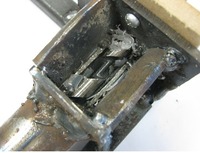 The opposite of a 3D printer would be a recycling machine. In other words, there should be a way to collect leftover material (or even leftover objects) and convert them back into a medium suitable for feedstock back into a personal manufacturing device for creation of new objects.
The opposite of a 3D printer would be a recycling machine. In other words, there should be a way to collect leftover material (or even leftover objects) and convert them back into a medium suitable for feedstock back into a personal manufacturing device for creation of new objects. No such universal device exists today for a variety of reasons, not the least of which is the fact that most 3D printers have very strong affinity for specific materials. Thus, recycling would have to sort out input “chaff” from “the right stuff”. Often that sorting would be done by you, not a machine.
There have been some limited experiments in this area; a good list of ideas can be found at MakerBot’s recycling wiki page, at least for plastic. In particular, the RepRap team has been thinking about such a device, in which raw PLA or other previously printed objects might be chopped up into tiny bits that could be recycled as input print material.
Another experiment by the Victoria University of Wellington has attempted to make a device that converts used plastic milk jugs into a plastic filament suitable for feeding into a MakerBot. Check out the RecycleBot here.
A discussion on the Open Manufacturing list is interesting, where Nicolas Dufour proposes a fantastic plasma torch-equipped device that would atomize material into a cloud, which would then be atomically sorted by a modified mass spectrometer into different categories. Fantastic, yes, but there’s no doubt a bit of work yet exists required to turn that notion into reality. What would you do with all the leftover atoms you didn’t need for your print material? How would you power such a device? Could this be financially feasible over simply buying raw material? Would it even be legal to own something like that? What would the neighbours think?
What are your thoughts on where 3D recycling should go?

